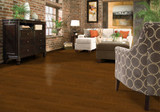Laminate vs. Other Floors

Each kind of flooring has strengths over the other kinds. At Floors To Your Home, we’re not the kind of people who pretend that everything we sell is good for everyone in every situation. Just as we won’t encourage you to install glue down vinyl plank on your ceiling or affirm your desire to place a floating laminate floor on the surface of your in ground pool, so we are not going to tell you that laminate flooring is best for a use which is really better served by, say, a hardwood floor. Laminate flooring is a great product, we would dare even say that it’s great most of the time. We’re going to tell you where and why, and we are also going to let you know when another kind of flooring might be a better choice for you.
Laminate Flooring and Solid Hardwood Flooring
Broadly speaking, solid hardwood wins on bringing value to a home, and on generational longevity. Laminate flooring wins on versatility. Both are beautiful. Laminates look like real wood with increasing authenticity, so that both laminate and hardwood can be installed to complete the look in an office or home with equal elegance.
Installation Versatility
Many Laminate floors can be installed both above and below ground level. Solid hardwood must go above ground level because below grade moisture can cause the boards to warp or cup. Since solid hardwood must always be attached to its subfloor with either some form of nail or adhesive, it may only be laid down directly on the surface of the subfloor. As long as an existing floor such as vinyl, or even an existing laminate floor, is attached to its subfloor, and is level and clean, you can install a new floating floor right over it. There is no need to tear up the pre-existing floor and re-level it before installing your new one. This goes for almost anything but carpet and some less than level stone tiling.
Typically, hardwood is 3/4″ thick, give or take a sixteenth of an inch. This
can make transitioning from your hardwood floor to another floor a bit
difficult. Imagine a kitchen with a few millimeters of vinyl on top of the
subfloor, and an adjoining family room into which you want to install 3/4″
hardwood on the same subfloor. You will leave an almost 1/2″ drop from one
room to the other. Even with a good transition piece, it can be a tripping
issue. The thickest laminate floors are just over 1/2″, including the pad
underneath.
Laminate flooring comes to you finished. So do many hardwoods, but some require finishing to be done on site, which adds a great deal to installation time and cost. Depending on the chemicals used, sometimes the home may not be occupied during the application. This just doesn’t happen with a laminate floor. Also, the protective layer on top of the laminated image is more resistant to scratching and abrasions, and completely impervious to changes from exposure to sunlight.
Other Considerations
Now since there will be a slight gap between a floating floor and the subfloor, your laminate floor will sound different than a nailed down, solid hardwood floor. Even with thicker pad underneath, the best laminate flooring will never sound exactly like a real hardwood floor.
Many hardwoods require oiling or waxing as regular upkeep. Sanding and refinishing may be needed as often as every 5-8 years. Laminate can scratch, but the remedies don’t require sanding and refinishing, and for general upkeep, regular sweeping and damp mopping is all that is needed. Laminate is better at handling both the scratching and the accidents that can come with pets.
Some hardwood floors can last a lifetime, or many generations, two ways to say the same thing – a very long time. Well taken care of laminates can last a long time, but not that long. The warranty can be your guide. Most of ours go for 25 years, though some are shorter, and a few are lifetime. The standard warranty for a laminate floor covers wear, fading and staining. There may also be a moisture component, but you should read the language of the warranty. Often it relies on your existing homeowner’s insurance policy. If that doesn’t cover moisture damage to a floor, the manufacturer’s warranty may only cover a portion of it. Do your homework when making a final product choice, and feel free to call us for any clarifications you need.
Finally there is the price. At the most general level, you should expect a laminate floor to cost about half of what a hardwood floor would for the same area.
Here’s a more detailed piece on Laminate vs. Hardwood.
Laminate and Vinyl
For longevity, laminate floors beat sheet vinyl, though the new tiles and planks can match laminate in expected life. Also with sheet vinyl, where the entire floor is covered with one, big piece, if you damage the floor by, say, dropping a kitchen knife, then you either cover the damage with a rug, patch it imperfectly with a spare piece cut into the area, or replace the entire floor. Laminate planks are much easier to get to and swap out should anything similar happen.
As with hardwood, vinyl requires more involved upkeep than does laminate. Vinyl flooring can require stripper, polish, cleaning and waxing materials, all of which can be expensive. Laminate needs to be swept and damp mopped.
Where vinyl outshines is in handling water. Laminate flooring can be extremely water resistant, but not completely waterproof. Almost all vinyl products, including the click together varieties, are 100% waterproof.
Laminate and Carpet
In some circumstances, a very well kept, frequently and properly cleaned
carpet will actually filter dust and allergens out of the air for you, and
then all of that cleaning can remove them from your home. In that way alone
can carpets be better for people with allergies. But in general, laminate is
considered to be better because most won’t or can’t do carpet cleaning to
that level, which takes carpet in the exact opposite direction, leaving it a
trap for those very particles. Laminate just has no place to grab or hold
allergens. This also makes laminate a cleaner floor type for your children
to play on.
Related blog posts: Laminate vs. Hardwood
https://www.floorstoyourhome.com/blog/laminate-flooring-vs-real-hardwood/
– – – –
David has written and made videos about flooring products and installation since 2011 at Floors To Your Home (.com), where he is also the PPC Manager, a Researcher, a Website & Marketing Strategy Team member, Videographer, Social Strategist, Photographer and all around Resource Jito. In my spare time I shoot and edit video, put together a podcast, explore film history, and mix music (as in ‘play with Beatles multi-tracks’). Connect with
W. David Lichty
Follow Team Floors To Your Home on Facebook

 Brown Tone
Brown Tone
 Red Tone
Red Tone
 Golden Tone
Golden Tone
 Gray Tone
Gray Tone
 Light Tone
Light Tone
 Medium Tone
Medium Tone
 Dark Tone
Dark Tone
 Multi Color
Multi Color



